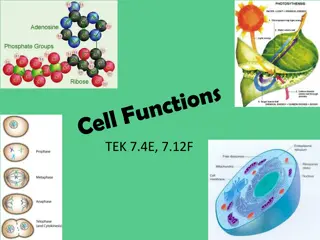Understanding Specialised Cells in Biology
Explore the concept of specialised cells in biology through learning objectives, examples of specialised cells in animals and plants, and explanations of cell adaptations for specific functions. Engage in activities such as cell labeling, video exploration, and self-assessment to deepen understanding of cell structures and functions.
Download Presentation

Please find below an Image/Link to download the presentation.
The content on the website is provided AS IS for your information and personal use only. It may not be sold, licensed, or shared on other websites without obtaining consent from the author. Download presentation by click this link. If you encounter any issues during the download, it is possible that the publisher has removed the file from their server.
E N D
Presentation Transcript
80/20 THINK! What do you NEED to cover with your set Grade Learning Objective Learning Outcome Recall what a specialised cell is 1 Describe some examples of specialised cells Describe examples of specialised plant and animals cells 2 Explain how some cells are adapted for their function 3
Specialised Cells Do now activity: Label the following parts of an animal and plant cell:
Progress indicators GOOD PROGRESS: Recall what a specialised cell is Describe examples of specialised plant and animals cells OUTSTANDING PROGRESS: Explain how some cells are adapted for their function
Specialised... Specialised... Specialised Cells Q: What does specialised mean?? Q: What is a specialised cell? A: A cell that has a special shape and features that help it to do it s job A: Something that is designed to do a particular job
There are lots of different types of specialised cells found in animals and plants. Task: Watch the video, try to note down as many specialised cells as you can and identify whether they are found in an animal or a plant. https://www.youtube.com/watch?v=u87QpOOkdxI
Self-assessment: Ciliated cell Sperm cell Nerve Cell Specialised Cells Palisade Cell Root Hair Cell Red Blood Cell Ovum (Egg Cell) Xylem Vessel
CELL CELL NAME FUNCTION (JOB) Task: Use the information on slide 8 and 9 to complete the table on slide 10.
Nerve Cell Red Blood Cell Structure Structure: Large surface area to hold lots of haemoglobin so oxygen can be carried Has no nucleus to make room for more oxygen Disk-shape to fit through narrow blood vessels Very long, elongated cells Nerve cells have branched at either end to make connections with many other nerve cells Function Function: To carry electrical nerve impulses around your body Egg Cell Structure Carries oxygen to respiring cells Sperm Cell Structure: Long tail to swim towards the egg cell Lots of mitochondria near tail to release energy to aid swimming Enzymes in the head of cell to digest outer layer of the egg cell Contains vesicles of fat and other nutrients which acts as a food source for the developing embryo Mitochondria to provide energy for cell division Function Function: To be fertilised by the sperm cell To swim towards the egg cell to fertilise it
Ciliated Epithelial Cell Structure: Lots of tiny hairs called cilia line the sirface of these cells Function: Cilia hairs sweep mucus containing trapped dirt/pathogens back up to the throat Stop lung/respiratory damage Palisade Cell Root Hair Cell Structure: Structure Large surface area to absorb large amount of sunlight Lots chloroplasts to increase sites of photosynthesis Large surface area Thin cell wall so water can pass through easily Function: Function To trap sunlight, carry out photosynthesis and generate food for the plant To be absorb minerals and water from the soil through the roots
Assessment Task Task: Answer the following exam style questions: 1. Name three organelles present in plant cells but not present in animal cells (3 marks) 2. Which type of specialised cell has a tail in order to swim (1 mark) 3. Describe how a red blood cell is adapted for it s function (2 marks) 4. Many cells need oxygen in order to survive, for which process is oxygen needed for? (1 mark)
Self-assessment: 1. Vacuole, chloroplast & cell wall. 2. A sperm cell has a tail in order to swim to the egg cell. 3. A red blood cell has no nucleus which means it can carry more oxygen, a red blood cell also has a disk shape so that it can fit through narrow blood vessels, it also has a large surface area to absorb more oxygen. 4. Oxygen is needed by cells in order to carry out respiration.
Specialised Cells - Job Advert Task: Write a job description for one of the specialised cells we have been looking at today. Example: WANTED!! A messenger who is RAPID at delivering messages! Must be: Extremely efficient at delivering signals Long and thin so messages are able to reach all over the body
Plenary ~ Copy & Complete: Specialised cells have special features/structures which allow them to carry ____________ cells have special _________ which allow them to carry out their functions. out their functions. Red blood cells carry __________ around the body, palisade cells are packed full of __________ to carry out ____________. carry out photosynthesis. Red blood cells carry oxygen around the body, palisade cells are packed full of chloroplasts to Sperm cells have streamlined head and long ________ which helps it to swim to towards the _______ cell. Sperm cells have streamlined head and long tails which helps it to swim to towards the egg cell.
Plenary What have you learnt today? Tweet a message remember only 140 characters! #keywords
Resources Resources
Nerve Cell Red Blood Cell Structure Structure: Large surface area to hold lots of haemoglobin so oxygen can be carried Has no nucleus to make room for more oxygen Disk-shape to fit through narrow blood vessels Very long, elongated cells Nerve cells have branched at either end to make connections with many other nerve cells Function Function: To carry electrical nerve impulses around your body Egg Cell Structure Carries oxygen to respiring cells Sperm Cell Structure: Long tail to swim towards the egg cell Lots of mitochondria near tail to release energy to aid swimming Enzymes in the head of cell to digest outer layer of the egg cell Contains vesicles of fat and other nutrients which acts as a food source for the developing embryo Mitochondria to provide energy for cell division Function Function: To be fertilised by the sperm cell To swim towards the egg cell to fertilise it
Ciliated Epithelial Cell Structure: Lots of tiny hairs called cilia line the sirface of these cells Function: Cilia hairs sweep mucus containing trapped dirt/pathogens back up to the throat Stop lung/respiratory damage Palisade Cell Root Hair Cell Structure: Structure Large surface area to absorb large amount of sunlight Lots chloroplasts to increase sites of photosynthesis Large surface area Thin cell wall so water can pass through easily Function: Function To trap sunlight, carry out photosynthesis and generate food for the plant To be absorb minerals and water from the soil through the roots























